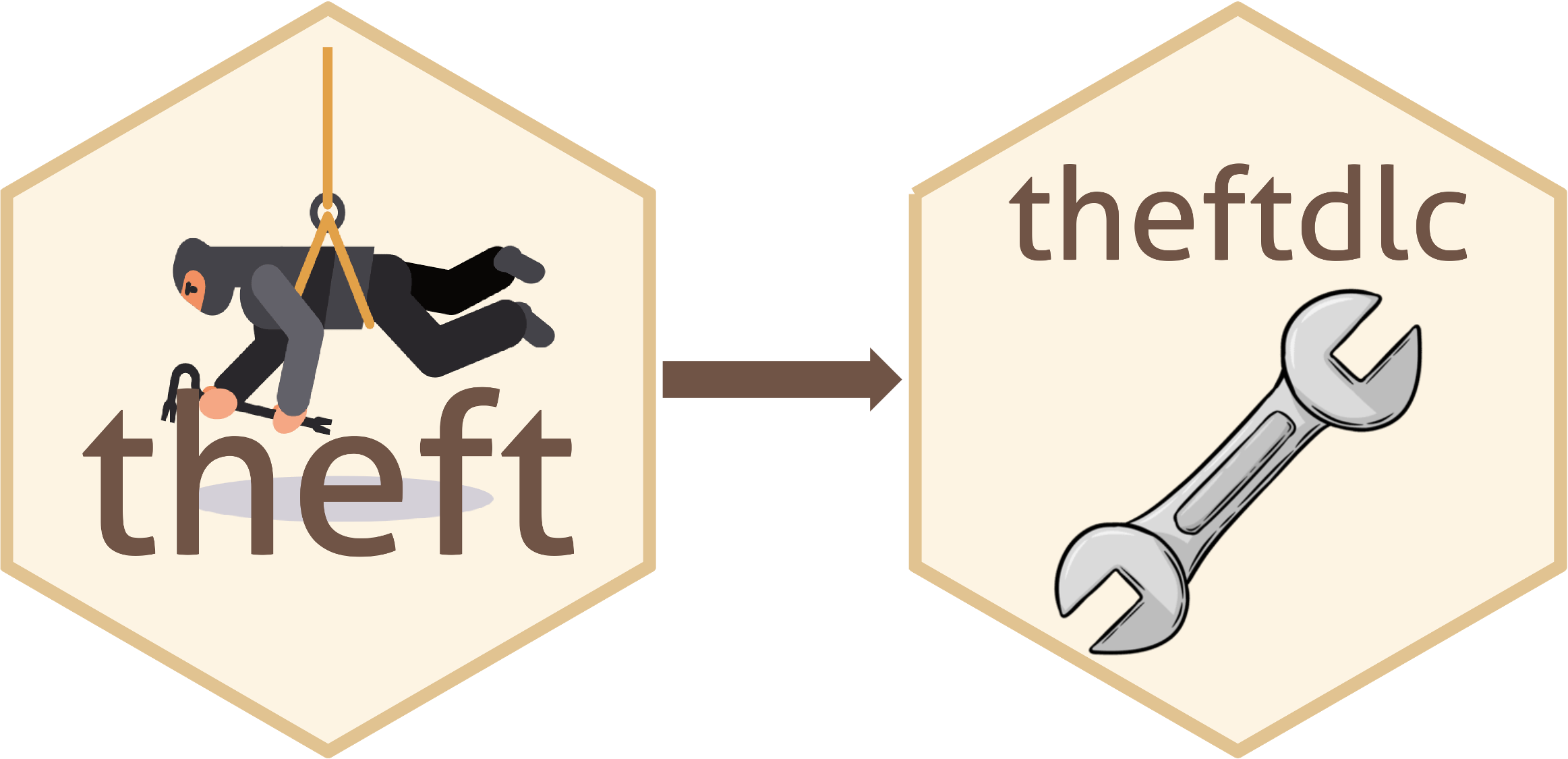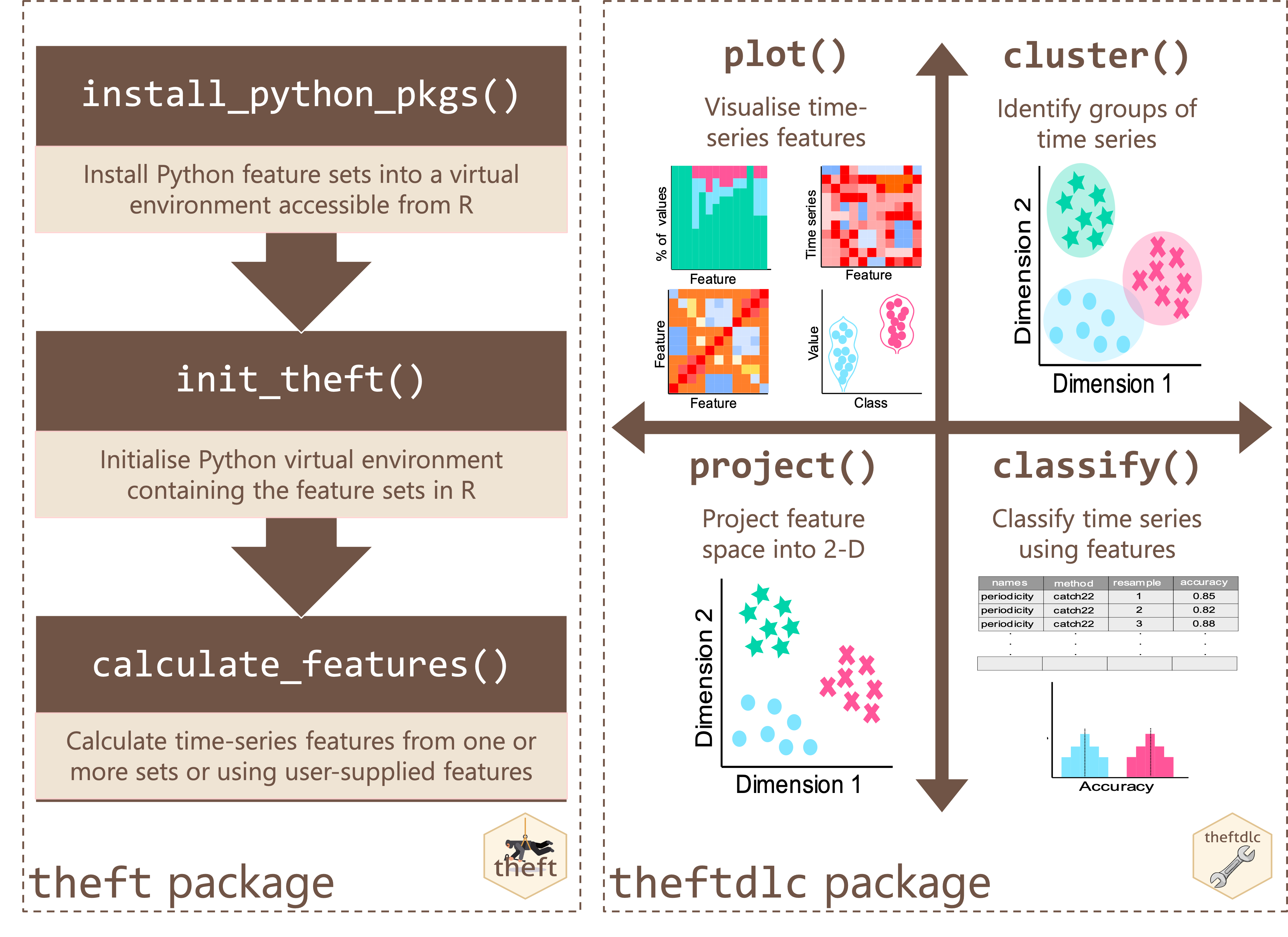Tools for Handling Extraction of Features from Time Series.
theft 
Tools for Handling Extraction of Features from Time series (theft)
Installation
You can install the stable version of theft from CRAN:
install.packages("theft")
You can install the development version of theft from GitHub using the following:
devtools::install_github("hendersontrent/theft")
Please also check out our paper Feature-Based Time-Series Analysis in R using the theft Package which discusses the motivation and theoretical underpinnings of theft and walks through all of its functionality using the Bonn EEG dataset — a well-studied neuroscience dataset.
General purpose
theft is a software package for R that facilitates user-friendly access to a consistent interface for the extraction of time-series features. The package provides a single point of access to $>1200$ time-series features from a range of existing R and Python packages. The packages which theft ‘steals’ features from currently are:
- catch22 (R; see
Rcatch22for the native implementation on CRAN) - feasts (R)
- tsfeatures (R)
- Kats (Python)
- tsfresh (Python)
- TSFEL (Python)
Note that Kats, tsfresh and TSFEL are Python packages. theft has built-in functionality for helping you install these libraries—all you need to do is install Python 3.9 on your machine. If you wish to access the Python feature sets, please run ?install_python_pkgs in R after downloading theft or consult the vignette in the package for more information. For a comprehensive comparison of these six feature sets across a range of domains (including computation speed, within-set feature composition, and between-set feature correlations), please refer to the paper An Empirical Evaluation of Time-Series Feature Sets.
As of v0.6.1, users can also supply their own features to theft (see the vignette for more information)!
Package extensibility
The companion package theftdlc (‘theft downloadable content’—just like you get DLCs and expansions for video games) contains an extensive suite of functions for analysing, interpreting, and visualising time-series features calculated from theft. Collectively, these packages are referred to as the ‘theft ecosystem’.

A high-level overview of how the theft ecosystem for R is typically accessed by users is shown below. Note that prior to v0.6.1 of, many of the theftdlc functions were contained in theft but under other names. To ensure the theft ecosystem is as user-friendly as possible and can scale to meet future demands, theft has been refactored to be just feature extraction, while theftdlc handles all the analysis of the extracted features. The deprecated names—such as tsfeature_classifier() being the outdated version of classify()—are also still available for now in theftdlc.

Many more functions and options for customisation are available within the packages and users are encouraged to explore the vignettes and helper files for more information.
Quick tour
theft and theftdlc combine to create an intuitive and efficient tidy feature-based workflow. Here is an example of a single code chunk that calculates features using catch22 and a custom set of mean and standard deviation, and projects the feature space into an interpretable two-dimensional space using principal components analysis:
library(dplyr)
library(theft)
library(theftdlc)
calculate_features(data = theft::simData,
group_var = "process",
feature_set = "catch22",
features = list("mean" = mean, "sd" = sd)) %>%
project(norm_method = "RobustSigmoid",
unit_int = TRUE,
low_dim_method = "PCA") %>%
plot()
In that example, calculate_features comes from theft, while project and the plot generic come from theftdlc.
Similarly, we can perform time-series classification using a similar simple workflow to compare the performance of catch22 against our custom set of the first two moments of the distribution:
calculate_features(data = theft::simData,
group_var = "process",
feature_set = "catch22",
features = list("mean" = mean, "sd" = sd)) %>%
classify(by_set = TRUE,
n_resamples = 5,
use_null = TRUE) %>%
compare_features(by_set = TRUE,
hypothesis = "null") %>%
head()
hypothesis feature_set metric set_mean null_mean
1 All features != own null All features accuracy 0.8400000 0.1688889
2 User-supplied != own null User-supplied accuracy 0.7066667 0.1111111
3 catch22 != own null catch22 accuracy 0.7066667 0.1600000
t_statistic p.value
1 9.089132 0.0004062310
2 5.512023 0.0026431488
3 7.363817 0.0009059762
In this example, classify and compare_features come from theftdlc.
Please see the vignette for more information and the full functionality of both packages.
Citation
If you use theft or theftdlc in your own work, please cite both the paper:
T. Henderson and Ben D. Fulcher. Feature-Based Time-Series Analysis in R using the theft Package. arXiv, (2022).
and the software:
To cite package 'theft' in publications use:
Trent Henderson (2024). theft: Tools for Handling Extraction of
Features from Time Series. R package version 0.6.1.
https://hendersontrent.github.io/theft/
A BibTeX entry for LaTeX users is
@Manual{,
title = {theft: Tools for Handling Extraction of Features from Time Series},
author = {Trent Henderson},
year = {2024},
note = {R package version 0.6.1},
url = {https://hendersontrent.github.io/theft/},
}
To cite package 'theftdlc' in publications use:
Trent Henderson (2024). theftdlc: Tools for Analysing and
Interpreting Time Series Features. R package version 0.1.0.
https://hendersontrent.github.io/theftdlc/
A BibTeX entry for LaTeX users is
@Manual{,
title = {theftdlc: Tools for Analysing and Interpreting Time Series Features},
author = {Trent Henderson},
year = {2024},
note = {R package version 0.1.0},
url = {https://hendersontrent.github.io/theftdlc/},
}